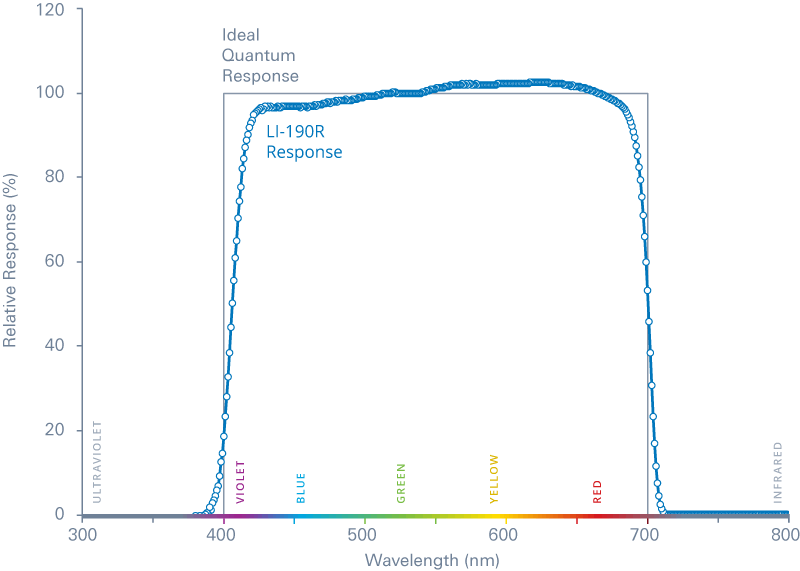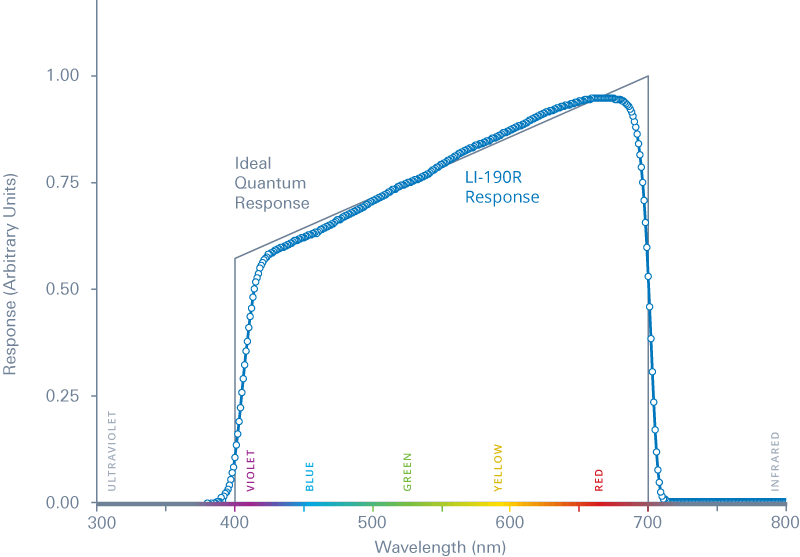Updated:2025-03-13
Views:2063
 WeChat
WeChat
 QQ
QQ
 Online Service
Online Service
 Technical Note
Technical Note  Brochure
Brochure
The LI-190R measures Photosynthetically Active Radiation (PAR, in µmol of photons -2 s-1). It provides accurate measurements—in the open, in greenhouses, under plant canopies, or in growth chambers—for most broad-spectrum light sources, including natural sunlight, artificial, or mixed sources.
Plants use light in the wavelength range from about 400 to 700 nm to drive photosynthesis. The efficiency with which plants use light varies somewhat across this range, but McCree1 showed that measuring PAR provided a consistent way to predict plant photosynthetic response regardless of the spectrum of the light source.2
Uniform sensitivity across the PAR waveband for accurate measurements outdoors, under vegetation, or in artificial lighting without changing the calibration
Newly designed optical filter tailors the spectral response to an unprecedented performance standard
Weather resistant and durable in high-temperature, high-humidity, long-term deployments
Cosine correction is accurate even when the light source is not directly overhead
Sensor heads are detachable and interchangeable for simplified installation, removal, and recalibration
The LI‑190R uses a high-quality silicon photodiode and glass optical filter to create uniform sensitivity to light between 400 nm to 700 nm, which closely corresponds to light used by most plants. A newly designed optical filter tailors the spectral response to an unprecedented performance standard. Furthermore, the new filter is unaffected by environmental factors such as heat or humidity. The filter blocks light with wavelengths beyond 700 nm, which is critical for measurements under vegetation where the ratio of infrared to visible light may be high.
The sensor features excellent cosine response, which ensures accurate measurements under diffuse light and when sunlight originates from a low solar angle. This, in combination with high resolution at low light levels, makes the LI-190R useful for determining the light compensation point in plants.

The figure above shows the LI-190R response and the ideal quantum response in photon units

The figure above shows the LI-190R response and the ideal quantum response in energy units
| Absolute Calibration | ± 5% traceable to the U.S. National Institute of Standards and Technology (NIST) |
| Sensitivity | Typically 5 μA to 10 μA per 1,000 μmol s-1 m-2 |
| Linearity | Maximum deviation of 1% up to 10,000 μmol s-1 m-2 |
| Response Time | Less than 1μs (2 m cable terminated into a 604 Ohm load) |
| Temperature Dependence | ± 0.15% per °C maximum |
| Cosine Correction | Cosine corrected up to 82° angle of incidence |
| Azimuth | < ± 1% error over 360° at a 45° elevation |
| Tilt | No error induced from orientation |
| Operating Temperature Range | −40 °C to 65 °C |
| Relative Humidity Range | 0% to 100% RH, Non-Condensing |
| Detector | High stability silicon photovoltaic detector (blue enhanced) |
| Sensor Housing | Weatherproof anodized aluminum body with acrylic diffuser and stainless steel hardware; O-ring seal on the sensor base |
| Size | 2.36 cm diameter × 3.63 cm (0.93” × 1.43”) |
| Weight | 24 g head; 60 g base/cable (2 m) with screws |
| Cable Length | 2 m, 5 m, 15 m, 50 m (6.5’, 16.4’, 49.2’, 164’) |
Customer Service QQ
Customer Hotline:
Technical Supports